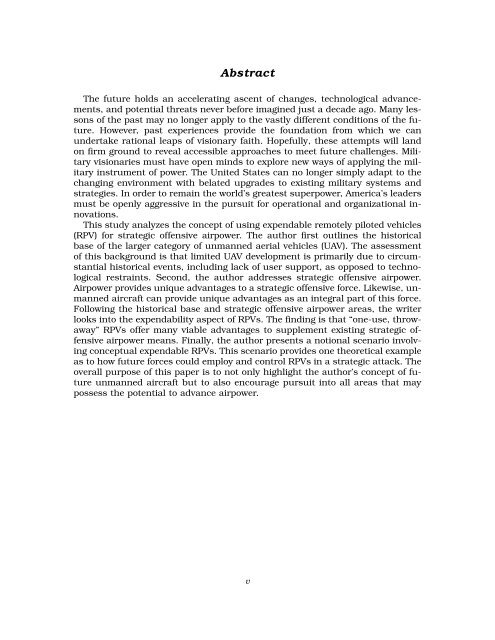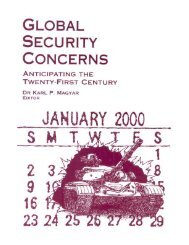Expendable Remotely Piloted Vehicles for Strategic Offensive ...
Expendable Remotely Piloted Vehicles for Strategic Offensive ...
Expendable Remotely Piloted Vehicles for Strategic Offensive ...
You also want an ePaper? Increase the reach of your titles
YUMPU automatically turns print PDFs into web optimized ePapers that Google loves.
AbstractThe future holds an accelerating ascent of changes, technological advancements,and potential threats never be<strong>for</strong>e imagined just a decade ago. Many lessonsof the past may no longer apply to the vastly different conditions of the future.However, past experiences provide the foundation from which we canundertake rational leaps of visionary faith. Hopefully, these attempts will landon firm ground to reveal accessible approaches to meet future challenges. Militaryvisionaries must have open minds to explore new ways of applying the militaryinstrument of power. The United States can no longer simply adapt to thechanging environment with belated upgrades to existing military systems andstrategies. In order to remain the world’s greatest superpower, America’s leadersmust be openly aggressive in the pursuit <strong>for</strong> operational and organizational innovations.This study analyzes the concept of using expendable remotely piloted vehicles(RPV) <strong>for</strong> strategic offensive airpower. The author first outlines the historicalbase of the larger category of unmanned aerial vehicles (UAV). The assessmentof this background is that limited UAV development is primarily due to circumstantialhistorical events, including lack of user support, as opposed to technologicalrestraints. Second, the author addresses strategic offensive airpower.Airpower provides unique advantages to a strategic offensive <strong>for</strong>ce. Likewise, unmannedaircraft can provide unique advantages as an integral part of this <strong>for</strong>ce.Following the historical base and strategic offensive airpower areas, the writerlooks into the expendability aspect of RPVs. The finding is that “one-use, throwaway”RPVs offer many viable advantages to supplement existing strategic offensiveairpower means. Finally, the author presents a notional scenario involvingconceptual expendable RPVs. This scenario provides one theoretical exampleas to how future <strong>for</strong>ces could employ and control RPVs in a strategic attack. Theoverall purpose of this paper is to not only highlight the author’s concept of futureunmanned aircraft but to also encourage pursuit into all areas that maypossess the potential to advance airpower.v






